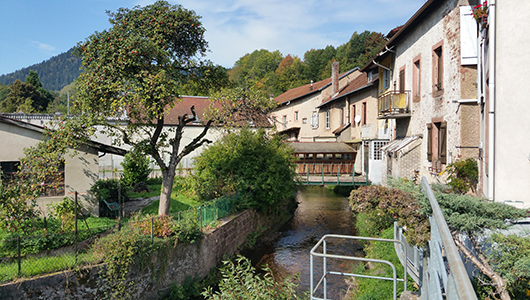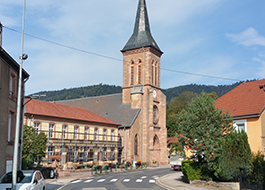La Petite-Raon
Durée visite : 20 minutes
Moyen : Pédestre
La Petite Raon est un village faisant partie du comté de Salm, échu à la partie lorraine en 1600, il est intégré dans la principauté de Salm-Salm formée en 1751. Après l’annexion de 1793, il constitue une commune du canton de Senones. La commune a été décorée, le 11 novembre 1948, de la Croix de guerre 1939-1945. Fils du maître d’école, Jean François Fréchard est né à La Petite Raon, village de la principauté de Salm-Salm en 1765. Moine bénédictin à Moyenmoutier puis à Senones, dom Joseph Fréchard devient prêtre réfractaire. Nommé curé de Colroy-la-Roche après le Concordat de 1801, il est un pédagogue précurseur des écoles normales dès 1804 et fonde l’institution des frères de la doctrine chrétienne dans le diocèse de Nancy.
The Petite Raon is a village part of the County of Salm, fallen to the Lorraine part in 1600, it is integrated in the principality of Salm-Salm formed in 1751. After the annexation of 1793, it constitutes a municipality of the canton of Senones . The commune was decorated, on November 11, 1948, with the Croix de Guerre 1939-1945. Son of the schoolmaster, Jean François Fréchard was born in La Petite Raon, village of the principality of Salm-Salm in 1765. Benedictine monk in Moyenmoutier then Senones, Dom Joseph Fréchard becomes a refractory priest. Appointed priest of Colroy-la-Roche after the Concordat of 1801, he was a pedagogue precursor of the normal schools since 1804 and founded the institution of the brothers of the Christian doctrine in the diocese of Nancy.
Das Petite Raon ist ein Dorfteil der Grafschaft Salm, das 1600 in Lothringen fiel und in das 1751 gegründete Fürstentum Salm-Salm integriert ist. Nach der Annexion von 1793 bildet es eine Gemeinde des Kantons Senones . Die Kommune wurde am 11. November 1948 mit dem Croix de Guerre 1939-1945 geschmückt. Jean François Fréchard, Sohn des Schulmeisters, wurde 1765 in La Petite Raon, einem Dorf des Fürstentums Salm-Salm, geboren. Der Benediktinermönch in Moyenmoutier und Senones, Dom Joseph Fréchard, wird ein widerspenstiger Priester. Er wurde nach dem Konkordat von 1801 zum Priester von Colroy-la-Roche ernannt, war seit 1804 Pädagoge-Vorläufer der normalen Schulen und gründete die Einrichtung der Brüder der christlichen Lehre in der Diözese Nancy.

De sinople au hérisson contourné d’argent mantelé d’or à deux saumons d’argent cantonnés de trois croisettes de sinople disposées 1 – 2.
Le hérisson est le symbole de la commune. Les saumons et les croisettes indiquent que La Petite Raon faisait partie de la Principauté de Salm comme sa voisine Senones. Cependant, ici les émaux sont changés : le gueules du champ est transformé en or, et les croisettes qui étaient d’argent sont de sinople.
The hedgehog is the symbol of the town. Salmon and croisettes indicate that La Petite Raon was part of the Principality of Salm like its neighbor Senones. However, here the enamels are changed: the mouths of the field is transformed into gold, and the croisettes which were of silver are vert.
Der Igel ist das Symbol der Stadt. Lachs und Croisettes weisen darauf hin, dass La Petite Raon wie seine Nachbarn Senones Teil des Fürstentums Salm war. Hier werden jedoch die Emails geändert: Die Mündungen des Feldes verwandeln sich in Gold, und die Croisetten, die aus Silber waren, sind vert.

Les habitants et les habitantes de La Petite Raon s’appellent les Petit-Raonnais et les Petit-Raonnaises.
The inhabitants of La Petite Raon are called the Petit-Raonnais and the Petit-Raonnaises.
Die Bewohner von La Petite Raon heißen Petit-Raonnais und Petit-Raonnaises
Les points de visites
.
L’église Saints-Sébastien-et-Quirin a été construite entre 1857 et 1865. Son orgue neuf est dû au facteur vosgien Henri Didier. Héritier de son père Charles, Henri Didier est né en 1861. Il rejoint les Antilles et y construit une dizaine d’instruments en Martinique, trois orgues à la Guadeloupe, six orgues au Vénézuéla et deux orgues à Trinidad. De retour en France il construit l’instrument de La Petite Raon, en 1902. Celui-ci est reconstruit par son fils François en 1924. Les tuyaux avaient été réquisitionnés par les Allemands en 1916. Une plaque en marbre est dédiée aux morts raonnais de 14-18. Saint Quirin de Rome est un saint martyr de l’Église catholique. Sa fête est célébrée le 30 avril. Refusant d’abjurer sa foi chrétienne, il subit le martyre en 130. On lui arrache la langue, on lui casse les os à coups de bâton, on le torture dans les flammes des torches. Quirin, soutenu par la grâce, garde son calme. Finalement, on lui coupe les mains et les pieds, et les bourreaux lui tranchent la tête. Tant de tourments valent à Saint Quirin d’être invoqué pour la guérison de nombreux maux. Citons le mal de tête et d’oreilles, les écrouelles, les oreillons, les rhumatismes, les fièvres et les maladies de la peau.
The church of Saints Sebastian and Quirin was built between 1857 and 1865. His new organ is due to the Vosges factor Henri Didier. Heir to his father Charles, Henri Didier was born in 1861. He joined the West Indies and built a dozen instruments in Martinique, three organs in Guadeloupe, six organs in Venezuela and two organs in Trinidad. Back in France he built the instrument of La Petite Raon, in 1902. It was rebuilt by his son François in 1924. The pipes were requisitioned by the Germans in 1916. A marble plaque is dedicated to the Raonnais dead of 14-18. Saint Quirin of Rome is a holy martyr of the Catholic Church. His birthday is celebrated on April 30th. Refusing to abjure his Christian faith, he suffered martyrdom in 130. They tear off their tongues, break their bones with sticks, and torture them in torch flames. Quirin, supported by grace, keeps his calm. Finally, his hands and feet are cut off, and the executioners cut off his head. So many torments are worth to Saint Quirin to be invoked for the cure of many evils. These include head and earache, scrofula, mumps, rheumatism, fevers and skin diseases.
Die Kirche der Heiligen Sebastian und Quirin wurde zwischen 1857 und 1865 erbaut. Seine neue Orgel ist dem Vogesen-Faktor Henri Didier zu verdanken. Henri Didier, der Nachfolger seines Vaters Charles, wurde 1861 geboren. Er schloss sich den Westindischen Inseln an und baute in Martinique ein Dutzend Instrumente, in Guadeloupe drei Orgeln, in Venezuela sechs und in Trinidad zwei Orgeln. Zurück in Frankreich baute er das Instrument von La Petite Raon im Jahr 1902. Es wurde 1924 von seinem Sohn François umgebaut. Die Pfeifen wurden 1916 von den Deutschen in Besitz genommen. Eine Marmortafel ist den Raonnais-Toten gewidmet 14-18. Saint Quirin von Rom ist ein heiliger Märtyrer der katholischen Kirche. Sein Geburtstag wird am 30. April gefeiert. Er weigerte sich, seinen christlichen Glauben abzulehnen, und erlitt 130 das Martyrium. Sie reißen sich die Zungen ab, brechen sich mit Stöcken die Knochen und foltern sie in Fackelflammen. Quirin, gestützt von der Gnade, bleibt ruhig. Schließlich werden ihm Hände und Füße abgeschnitten und die Scharfrichter schneiden ihm den Kopf ab. Für Saint Quirin sind so viele Qualen wert, dass sie zur Heilung vieler Übel herangezogen werden. Dazu gehören Kopf- und Ohrenschmerzen, Scrofula, Mumps, Rheuma, Fieber und Hautkrankheiten.
.
.
Près de l’église, un obélisque sur socle est en granit. Il est orné de palmes entrecroisées et d’un médaillon avec tête de poilu. Il est dédié aux victimes civiles et militaires des deux guerres mondiales, avec notamment les déportés du travail. Une plaque est apposée sur la façade de la mairie. Elle rappelle les sacrifices des habitants de la Petite-Raon pendant l’occupation. 196 déportés dont 75 seulement revinrent. Pour deux victimes avant 1944, on compte pour cette année de combats de libération, l’essentiel des déportés.
Near the church, an obelisk on base is granite. It is adorned with intertwined palms and a medallion with hairy head. It is dedicated to the civilian and military victims of the two world wars, including the deportees of work. A plaque is affixed to the facade of the town hall. It recalls the sacrifices of the inhabitants of Petite-Raon during the occupation. 196 deportees of whom 75 only returned. For two victims before 1944, we count for this year of fights of liberation, the majority of the deportees.
In der Nähe der Kirche befindet sich ein Obelisk aus Granit. Es ist mit verschlungenen Palmen und einem Medaillon mit behaartem Kopf geschmückt. Es ist den zivilen und militärischen Opfern der beiden Weltkriege gewidmet, einschließlich der Deportierten der Arbeit. An der Fassade des Rathauses ist eine Gedenktafel angebracht. Es erinnert an die Opfer der Bewohner von Petite-Raon während der Besatzung. 196 Deportierte, von denen nur 75 zurückkehrten. Für zwei Opfer vor 1944 zählen wir für dieses Jahr der Befreiungskämpfe die Mehrheit der Deportierten.







